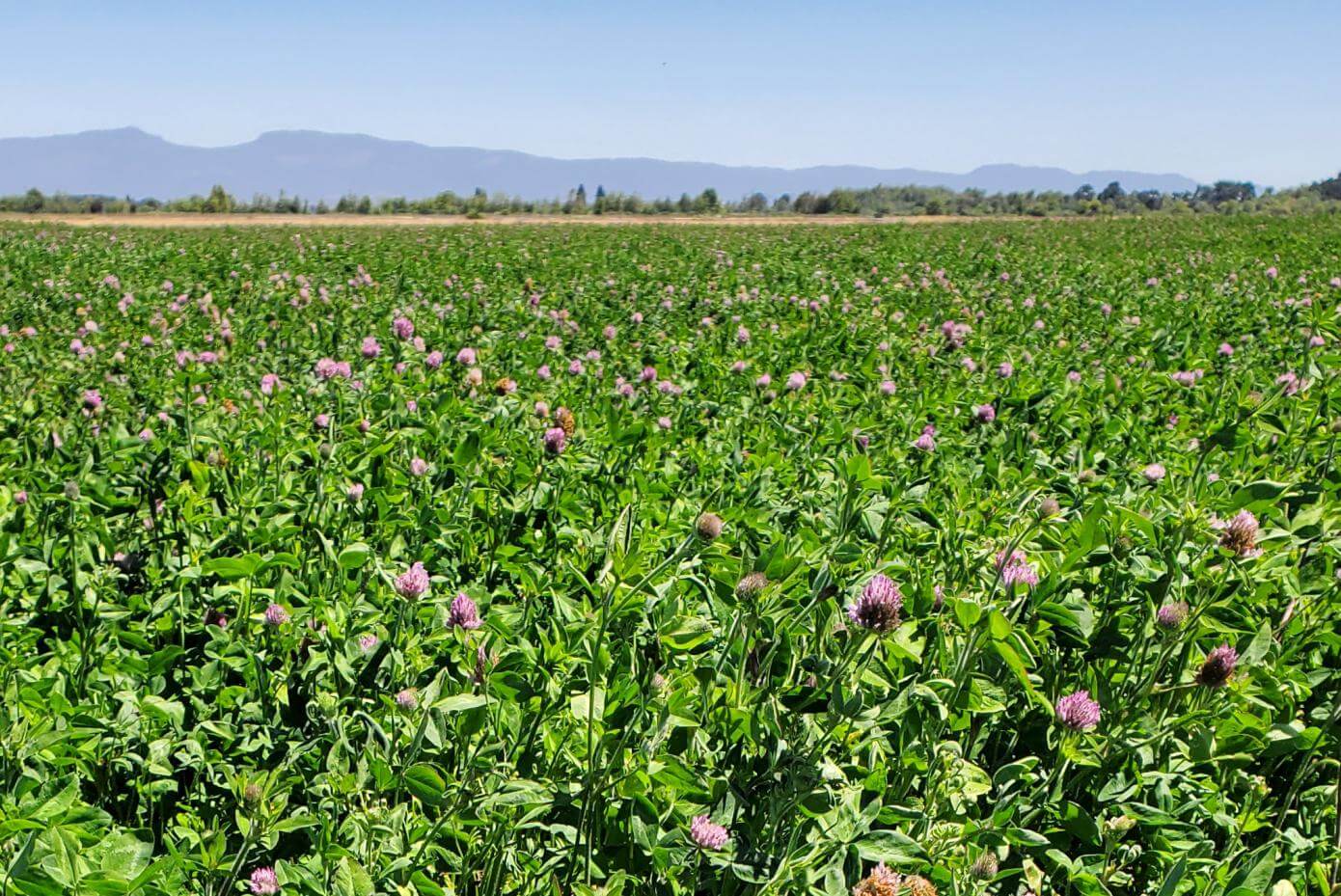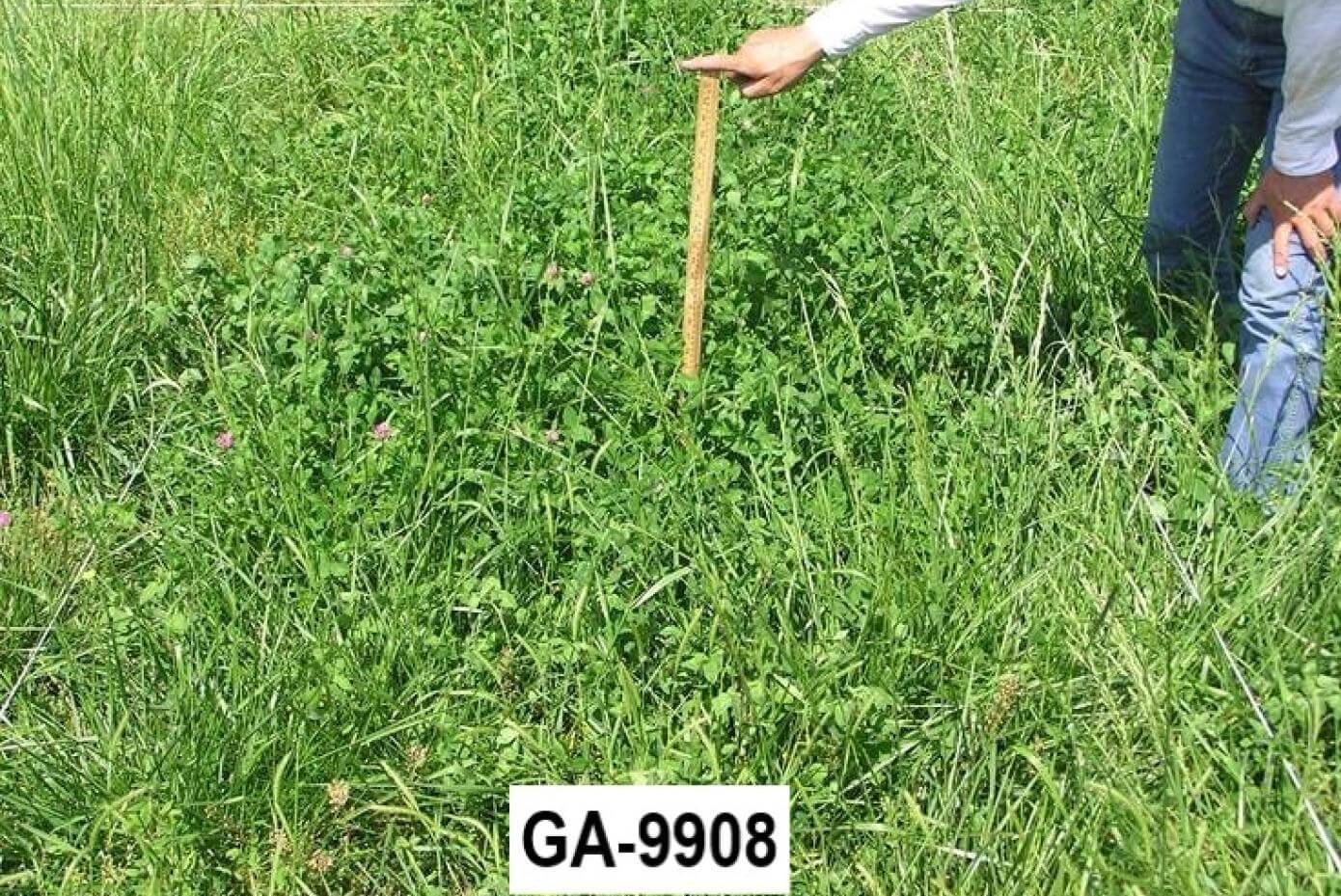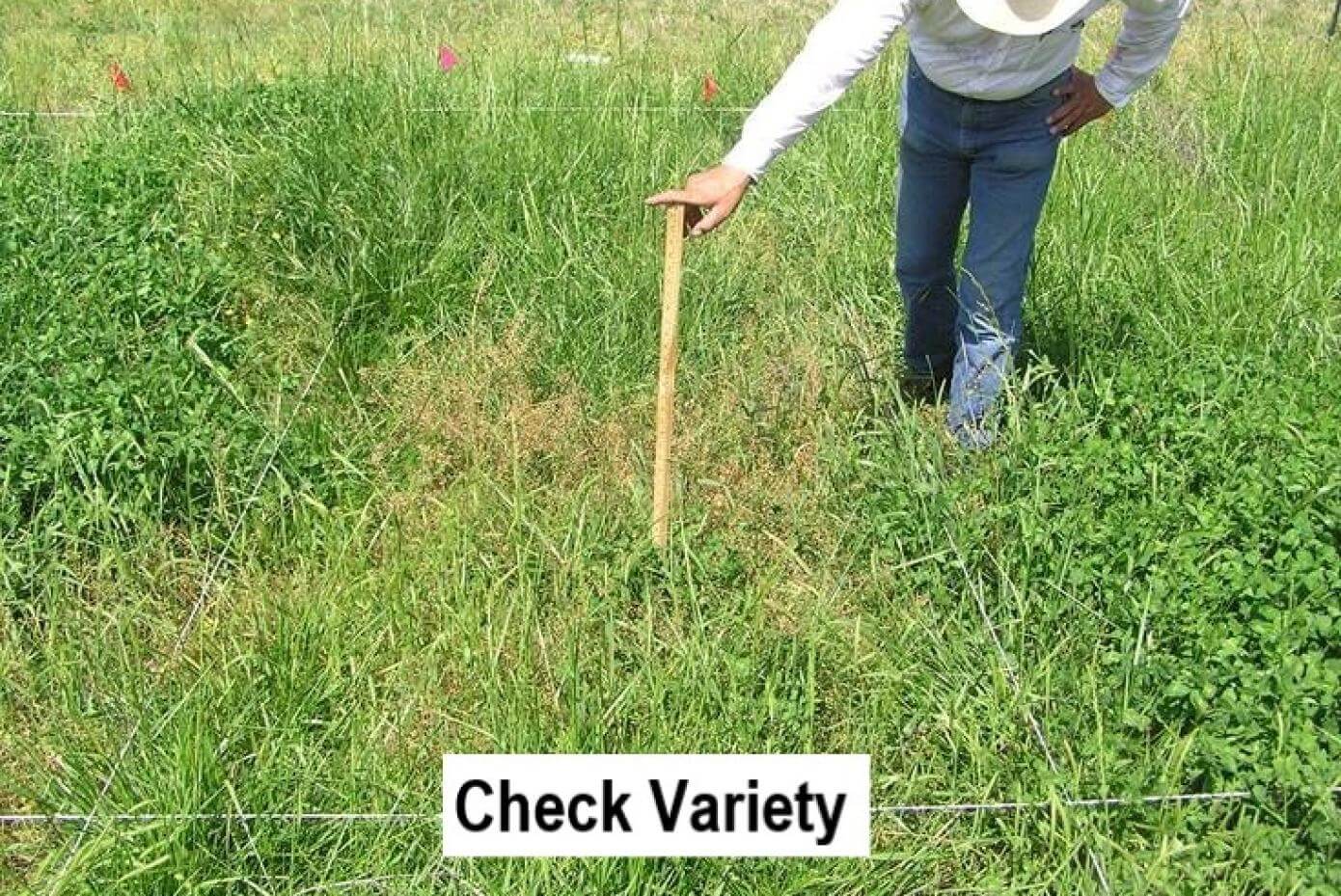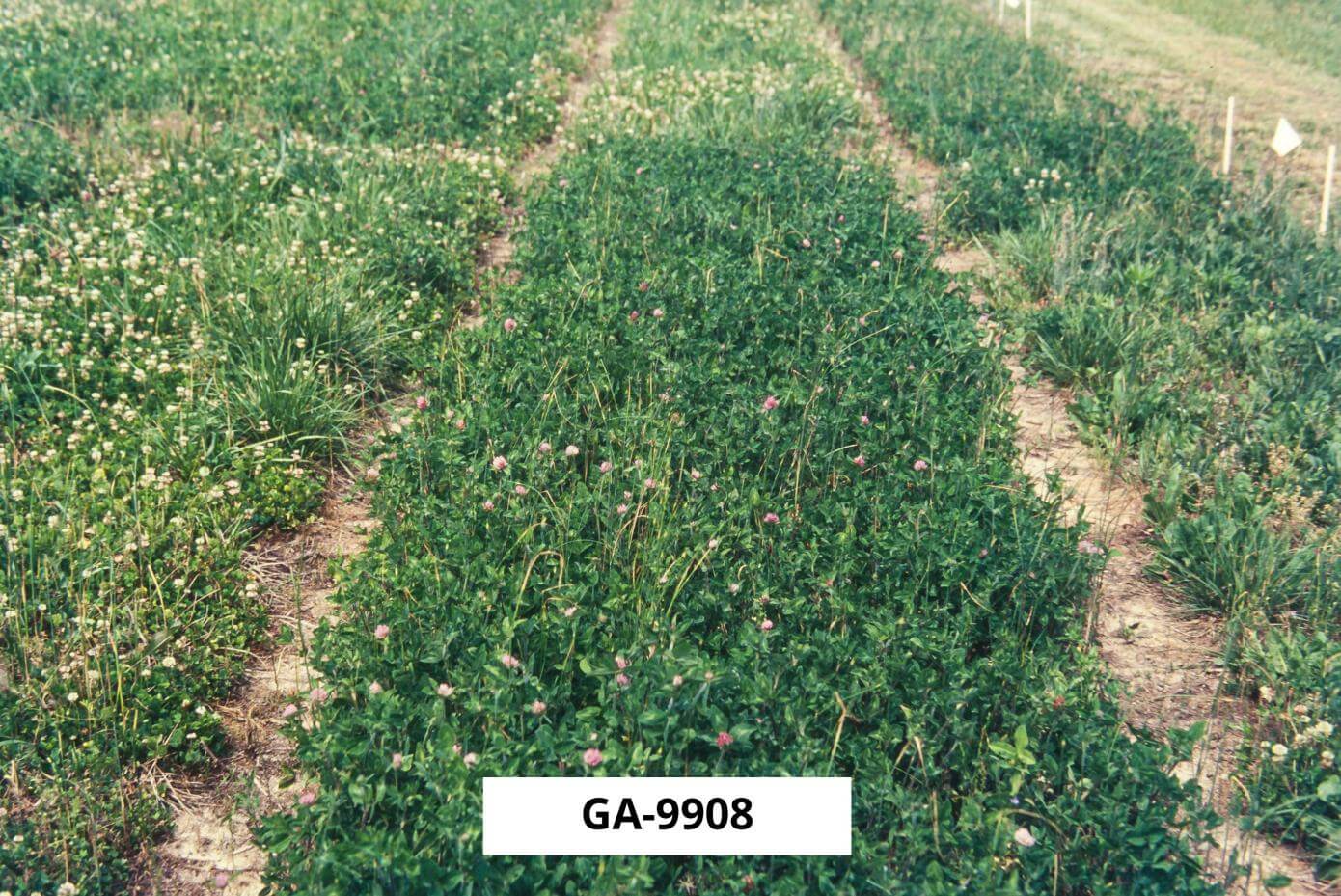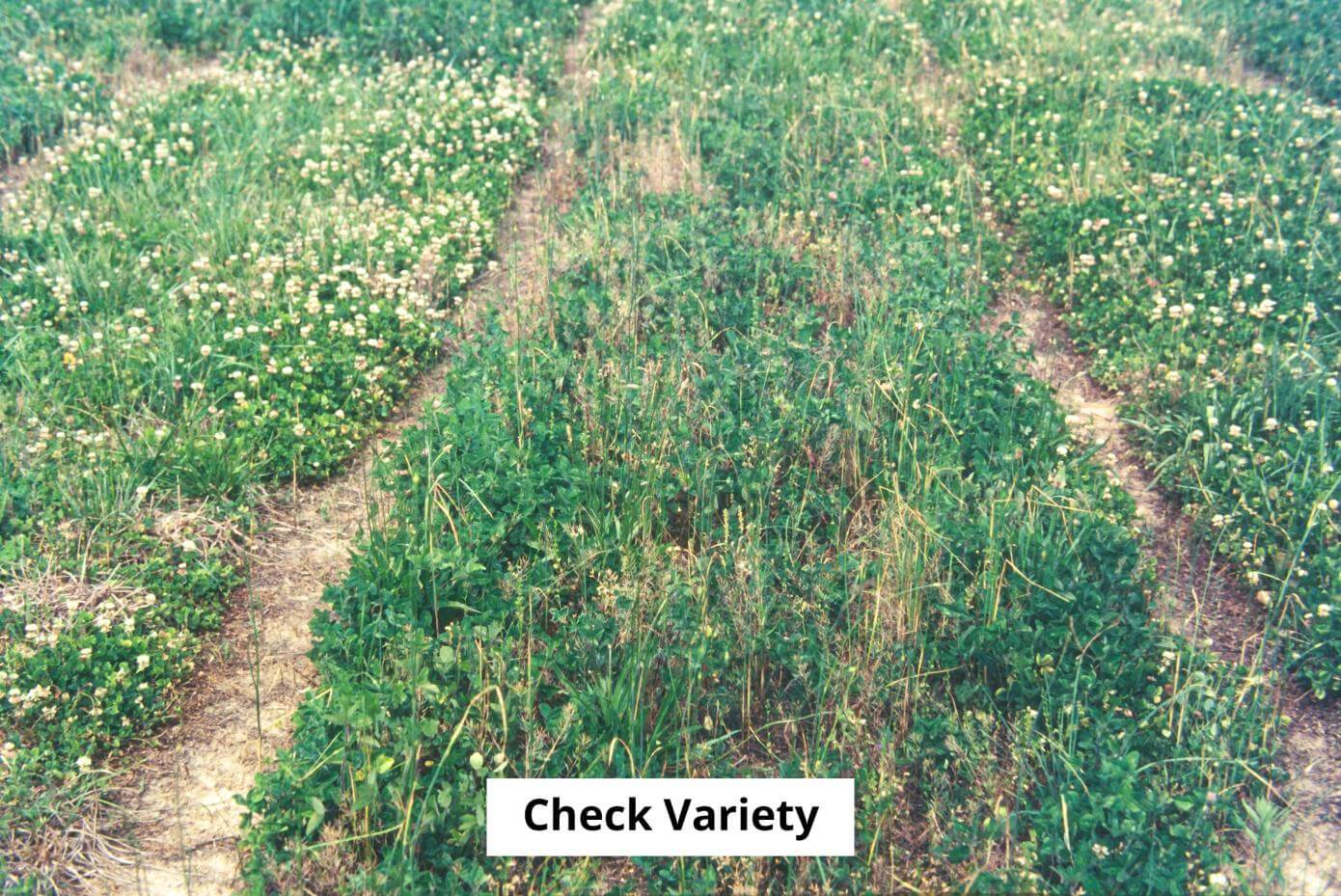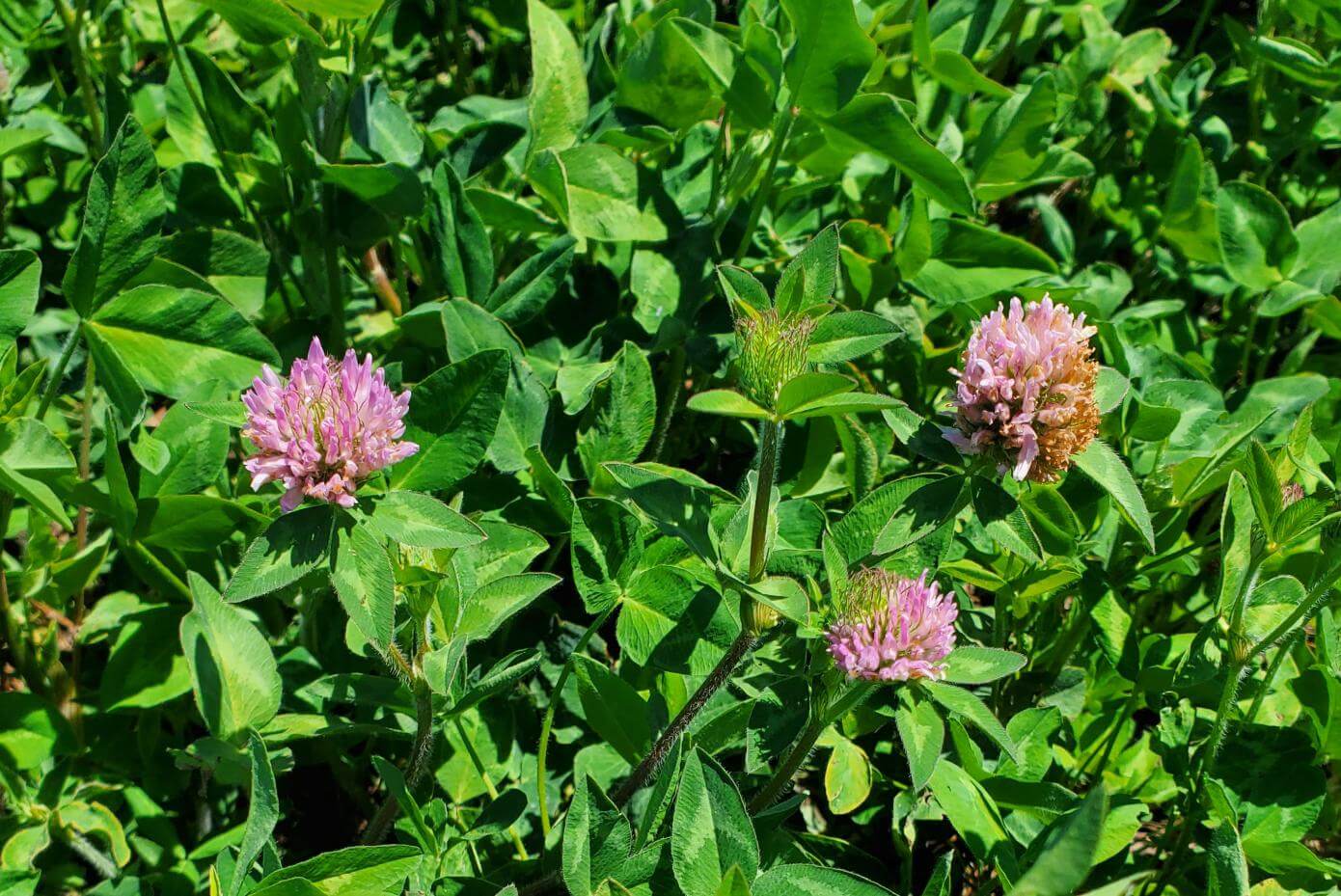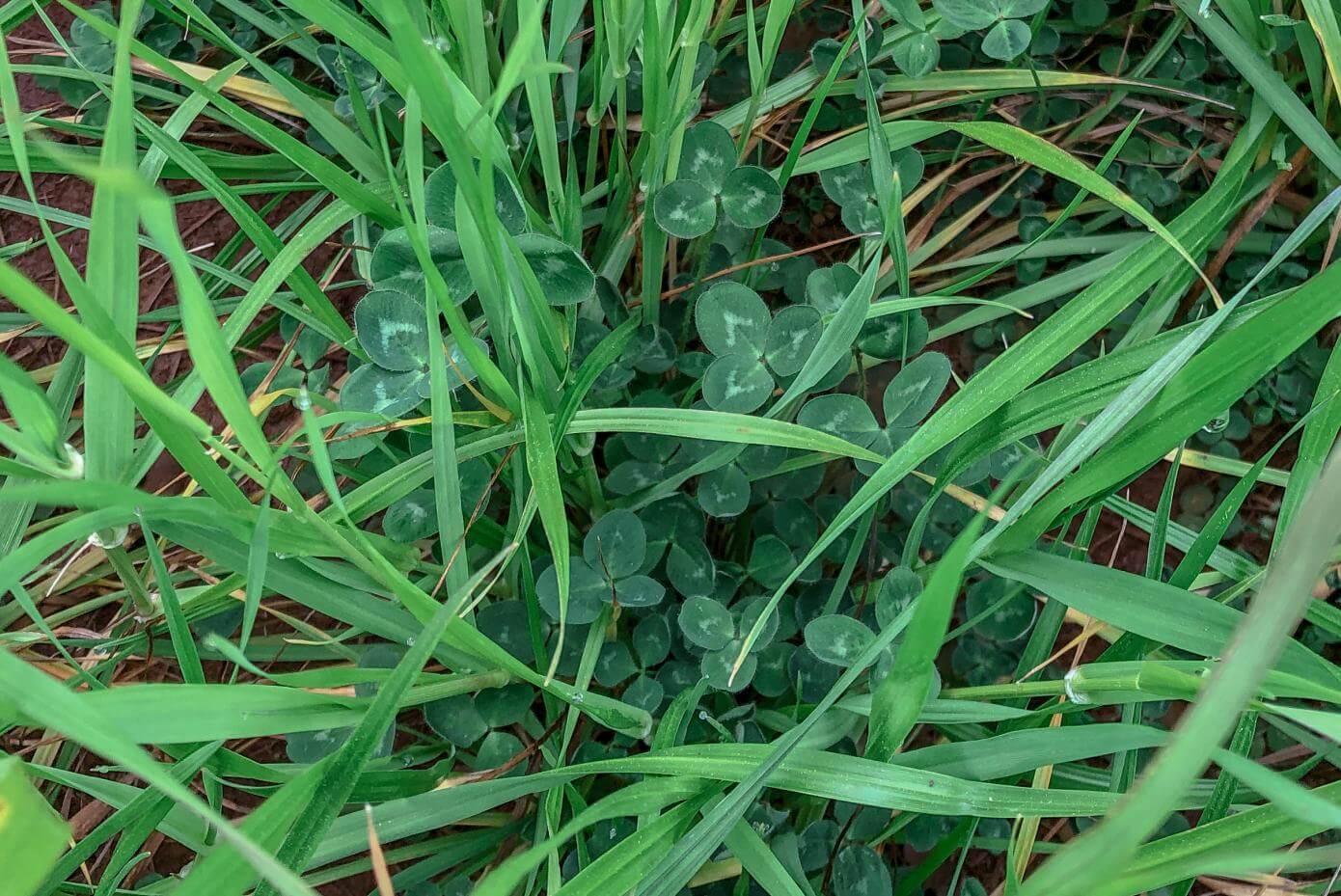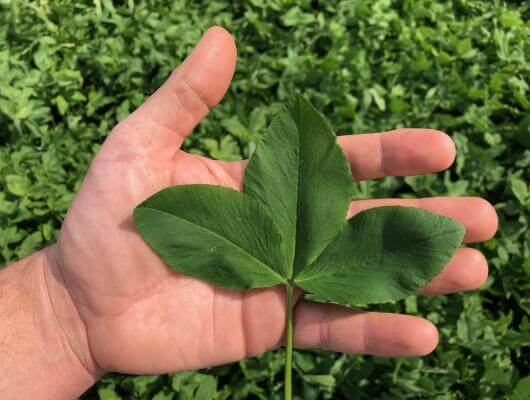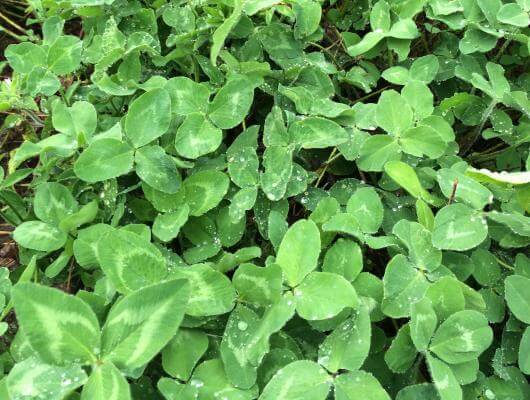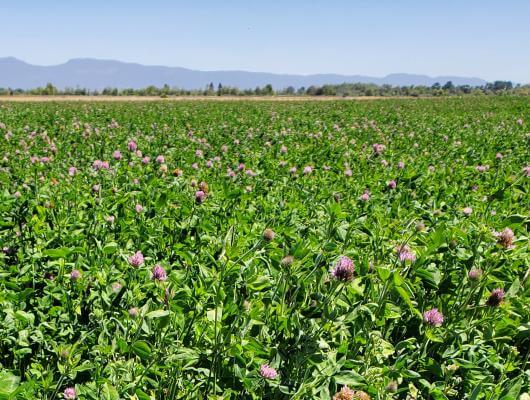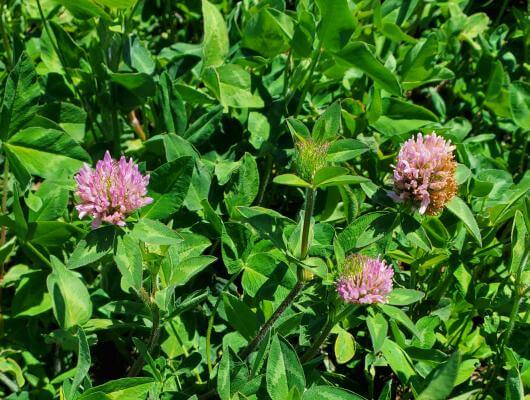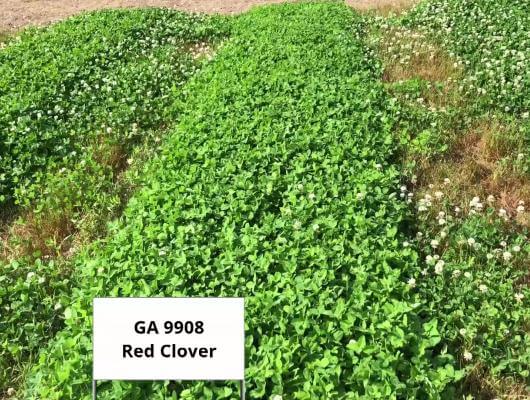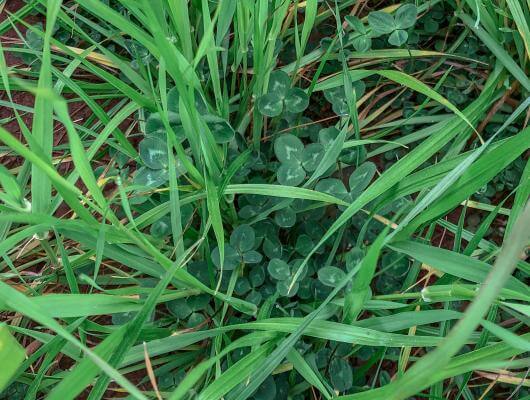GA-9908 Medium Red Clover
A southern adapted clover bred for improved grazing performance, GA-9908 is a valuable forage for hay, grazing, cover cropping and wildlife.
Variety Summary
GA-9908 is a southern adapted, medium red clover specifically bred for improved grazing performance. GA-9908 is a multi-year red clover capable of better persistence and good hay yields. It is highly resistant to Southern Anthracnose. GA-9908 is a valuable forage for hay, grazing, cover cropping and wildlife. As with all red clovers, it possesses deep roots to help build soil and provide extended drought survivability and is capable of fixing nitrogen; all useful traits for crop rotations and mixed grass pastures.
Better Grazing Persistence
Developed by Dr. Joe Bouton at University of Georgia, GA-9908 was selected from ‘Redland III’ through multiple cycles of intensive grazing. GA-9908 was then tested for grazing survival at three Georgia locations. Plots were seeded in the fall, as pure stands (Tifton) or into tall fescue swards (Eatonton and Calhoun). As shown in the photos, GA-9908 was found to provide improved grazing survival and yield compared to other widely used varieties (actual data available on request).
High Forage Yields
Trial results in the southern and northern US indicate that GA-9908 is able to supply high forage yields for multiple years, if adequate growing conditions exist. In both a 2-year University of Tennessee trial (shown in table) and a 4-year University of Wisconsin trial, GA-9908 had forage yields equivalent to other widely used varieties.
Georgia
Forage Yield (Tons DM/A)
Athens, GA
|2000-2002
| Variety | 2000 | 2001 | 2002 | 3-yr total |
|---|---|---|---|---|
| GA-9908 | 3.28 | 4.45 | 1.84 | 9.57 |
| Redland III | 2.84 | 4.34 | 2.1 | 9.28 |
| Royal | 3.64 | 3.35 | 0.78 | 7.77 |
| Lsd | 0.38 | 0.46 | 0.48 |
Tennessee
University of Tennessee
Forage Yield (Tons DM/A)
Greeneville & Knoxville, TN
|2009-2011
| Greeneville | Knoxville | Both locations | |||||
|---|---|---|---|---|---|---|---|
| Variety | 2010 | 2011 | 2-yr total | 2010 | 2011 | 2-yr total | 2-yr ave |
| GA-9908 | 4.07* | 4.55* | 8.62* | 3.19* | 2.95* | 6.14* | 7.38 |
| Freedom! | 4.31* | 4.35* | 8.67* | 3.04* | 3.02* | 6.06* | 7.37 |
| Freedom!MR | 4.06* | 4.39* | 8.45* | 3.32* | 2.90* | 6.22* | 7.34 |
| Emerald | 3.90* | 4.19* | 8.08* | 3.06* | 3.23* | 6.30* | 7.19 |
| Cinnamon Plus | 3.96* | 4.14* | 8.10* | 2.99* | 3.26* | 6.25* | 7.18 |
| CW 30091 | 3.75* | 4.49* | 8.24* | 3.10* | 2.82* | 5.92* | 7.08 |
| LS 9703 | 3.76* | 4.40* | 8.15* | 2.89* | 2.97* | 5.86* | 7.01 |
| CW202 | 3.86* | 4.26* | 8.12* | 2.97* | 2.69* | 5.66* | 6.89 |
| PGI 33 | 3.79* | 3.82 | 7.62 | 2.91* | 2.67* | 5.58* | 6.60 |
| FLMD | 4.04* | 3.81 | 7.85* | 3.08* | 1.90 | 4.98 | 6.42 |
| lsd | 0.67 | 0.68 | 1.03 | 0.57 | 0.71 | 0.91 | |
Wisconsin
University of Wisconsin
Forage Yield
Prairie du Sac, WI
|2013-2016
| Total Tons DM/A | % Stand Average | |||||||
|---|---|---|---|---|---|---|---|---|
| Variety | 2013 | 2014 | 2015 | 2016 | Total | 2014 | 2015 | 2016 |
| Starfire II | 2.49* | 5.28* | 4.03* | 2.07* | 14.50* | 100* | 83* | 57* |
| Freedom!MR | 2.79* | 4.78* | 3.83* | 2.32* | 13.72* | 100* | 81* | 37 |
| GA-9908 | 2.57* | 4.89* | 3.70* | 2.19 | 13.34* | 100* | 70* | 34 |
| Freedom! | 2.55* | 4.74 | 3.40 | 2.22* | 12.92 | 100* | 75* | 30 |
| Cinnamon Plus | 2.19 | 4.78* | 3.68* | 2.02 | 12.67 | 100* | 79* | 33 |
| Marathon | 2.14 | 4.56 | 3.42 | 2.10 | 12.21 | 100* | 69* | 21 |
| Emarwan | 2.35 | 4.18 | 2.72 | 1.67 | 10.92 | 98* | 46 | 13 |
| Tempus | 1.96 | 4.24 | 2.66 | 1.52 | 10.38 | 88 | 14 | 2 |
| Aberclarret | 2.04 | 4.00 | 2.54 | 1.65 | 10.23 | 87 | 21 | 10 |
| LSD (0.05) | 0.34 | 0.53 | 0.55 | 0.49 | 1.41 | 8 | 14 | 18 |
Very Good Disease Resistance
In independent testing, GA-9908 has shown to be highly resistant to Southern Anthracnose (Colltrotrichum spp.), and resistant to Northern Anthracnose (Auereobasidium caulivor).
ABI Alfalfa
Disease Resistance
Napier, IA
|2003
| Southern Anthracnose (Colltrotrichum spp.) | Northern Anthracnose (Auereobasidium caulivor) | |||
|---|---|---|---|---|
| Variety | Resistance Class | % Resistance | Resistance Class | % Resistance |
| GA-9908 | HR | 62.91 | R | 44.01 |
| FK345 | R | 47.28 | R | 44.85 |
| W1-2 | R | 38.46 | R | 39.64 |
| Kenland | MR | 29.06 | MR | 22.51 |
| Lsd | 6.96 | 5.86 | ||
Cover Crop Performance
In the October of 2019, researchers with the University of Tennessee planted extensive cover crop trials in three Tennessee locations – Knoxville, Spring Hill, and Milan. In addition to assessments of nitrogen content and release, assessment were conducted for ground cover, biomass and height. The data below reflects averages of all three sites. Site-specific data and complete results available upon request.
University of Tennessee
Biomass, Canopy Cover, and Height
Three Location Average
|2019-2020
| Variety | Biomass (Tons DM/A) | Canopy Cover (%) | Height (in) | |||||
|---|---|---|---|---|---|---|---|---|
| Apr | May | Nov | Feb | Nov | Feb | Apr | May | |
| GA-9908 | 0.1 | 0.7 | 3 | 11 | 1 | 1 | 3 | 11 |
| Big Red | 0.1 | 0.6 | 3 | 7 | 1 | 1 | 2 | 8 |
| VNS | 0.1 | 0.5 | 3 | 9 | 1 | 1 | 3 | 9 |
| Blaze | 0.1 | 0.4 | 3 | 9 | 1 | 1 | 4 | 9 |
University of Tennessee
Nitrogen Content/Estimated Nitrogen Release
Three Location Average
|2019-2020
| Variety | Biomass (Tons DM/A) | Total Nitrogen (%) | Est. N Released: April Termination (lbs/ac) | Est. N Released: May Termination (lbs/ac) | ||||||
|---|---|---|---|---|---|---|---|---|---|---|
| April | May | April | May | 2 wks. | 4 wks. | 12 wks | 2 wks. | 4 wks. | 12 wks | |
| GA-9908 | 0.1 | 0.7 | 2.5 | 3.0 | 0.0 | 0.3 | 2.0 | 1.3 | 3.3 | 24.0 |
| VNS | 0.1 | 0.5 | 2.2 | 3.0 | 0.0 | 0.0 | 1.0 | 1.0 | 2.0 | 17.0 |
| Big Red | 0.1 | 0.6 | 2.3 | 2.6 | 0.0 | 0.0 | 1.3 | 0.7 | 2.0 | 16.3 |
| Blaze | 0.1 | 0.4 | 2.3 | 2.9 | 0.0 | 0.0 | 0.7 | 1.0 | 2.0 | 14.0 |
Management of GA-9908
Once established and properly managed, GA-9908 should provide multiple years of free nitrogen and protein-rich hay and grazing. Longevity will depend on location and management. In hotter regions, with predominately warm-season species, it should last at least 1-2 years, while in cooler climates it should live 3-5 years, or longer. One can also broadcast 3-5 lbs./acre of seed annually, or as needed, to insure a continuous stand. Researchers recommend 25-30% clover percentages in grass pastures for best animal grazing results.
Planting Instructions
Before You Plant
GA-9908 performs best in soils with a pH of 5.8-7.0, but can also tolerate moderately acid soils (pH 5.0-5.5). GA-9908 will perform best on loamy, well-drained, fertile soil, but can also survive in poorly drained soil. For optimal performance, conduct a soil test and follow the recommended lime and fertilizer recommendations.
In established pastures, remove excess forage through grazing or late season haying. This will help ensure successful seedling emergence and establishment. Reduce weed population prior to planting. Be aware of herbicide carryover/residual of chemicals applications prior to planting.
Planting Method
Cultipacking or dragging before and after seeding helps create a firm seedbed on prepared land. Planting too deep may lead to poor establishment or stand failure. When planting as mix with grass, drill companion grasses in one direction and then drill clover perpendicular to grass rows.
Inoculation
GA-9908 is ready to plant! GA-9908 red clover is Nitro-Coated® with a high level of the leguminosarum biovar trifolii rhizobium.
Seeding Rate
Planting Dates
Planting Map
Planting Depth
1/8-1/4"
Optimal pH
5.8-7.0
Fertilizer
Apply lime, potassium and phosphorus per soil test results. No nitrogen is necessary.
